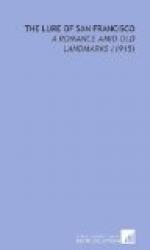“Was it where that little green Chinese building with the bracketed columns and turned-up eaves is?” I interposed.
“The telephone exchange, you mean? Exact spot. They used to ring a hand bell in the Plaza on Sunday mornings to call the Mormons to hear Brannan preach in the Casa Grande.”
“Richardson’s house!” My companion sent me an appreciative glance.
“Sure, but that was before most of ’em, including Sam, went back on their faith. Next to the Custom House on the south,” he continued, “was the Public Institute. It wasn’t much to look at—just pine boards—but it was considerable useful. They held the Public School there and had preaching on Sundays ’til the teacher, the preacher and all the audience went off to the mines. They tried the Hounds there, too.”
“The Hounds?” my friend looked dazed.
“Yes, the Sidney Coves that lived in Sidneyville, along there on Kearny near Pacific.” Light had failed to dawn.
“Here on the corner of Kearny,” continued the Forty-niner, “was an old adobe building with a red-tiled roof and a veranda around it.”
“The City Hotel!” I exclaimed delightedly.
“How did you know?” He eyed me curiously.
“My grandfather was a near-forty-niner,” I reminded him.
“Oh yes. Too bad! Too bad!” he added sympathetically. “It was the house and store of a fellow named Leidesdorff,” he continued, “who did a lot of trading with the Yankee skippers in Mexican days, and it was turned into a hotel in the gold rush. It was always the swell place for blowouts. They had a big banquet and ball there for Governor Stockton, I’m told, after the procession and speeches in the Plaza, and another the next year for Governor Kearny; the first Relief Committee met here, called by Brannan, Howard and Vallejo, to send rescuers to the Sierras for the survivors of the Donner Party. There wasn’t much of any importance in the way of gathering that didn’t happen there.”
We instinctively looked across at the square, three-story, pressed-brick home of the Chinese Consulate and bank.
“Every big fire took at least one side of the Plaza, and the sixth, in June of fifty-one, wiped out the whole square. That adobe was the last link between the Spanish village of Yerba Buena and its American successor, San Francisco,” he regretted, “but it was a good thing for the city, for they began to build with stone and brick after that. Did you see the Parrott Building, as you came along, on California and Montgomery?” he asked.
The Easterner turned to me. “You didn’t show me that,” he said, reprovingly.
“No, why should I? It wasn’t built until fifty-two.”
He ignored my insinuation and turned back to his informer. “What about the Parrott Building? It sounds like an aviary.”
“Not exactly,” he smiled. “It was made of granite blocks, cut and dressed and marked in China and then shipped over and set up by the ‘China Boys,’ as the Orientals here called themselves.”




